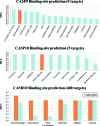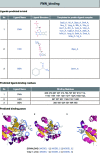GalaxySite: ligand-binding-site prediction by using molecular docking
- PMID: 24753427
- PMCID: PMC4086128
- DOI: 10.1093/nar/gku321
GalaxySite: ligand-binding-site prediction by using molecular docking
Abstract
Knowledge of ligand-binding sites of proteins provides invaluable information for functional studies, drug design and protein design. Recent progress in ligand-binding-site prediction methods has demonstrated that using information from similar proteins of known structures can improve predictions. The GalaxySite web server, freely accessible at http://galaxy.seoklab.org/site, combines such information with molecular docking for more precise binding-site prediction for non-metal ligands. According to the recent critical assessments of structure prediction methods held in 2010 and 2012, this server was found to be superior or comparable to other state-of-the-art programs in the category of ligand-binding-site prediction. A strong merit of the GalaxySite program is that it provides additional predictions on binding ligands and their binding poses in terms of the optimized 3D coordinates of the protein-ligand complexes, whereas other methods predict only identities of binding-site residues or copy binding geometry from similar proteins. The additional information on the specific binding geometry would be very useful for applications in functional studies and computer-aided drug discovery.
© The Author(s) 2014. Published by Oxford University Press on behalf of Nucleic Acids Research.
Figures



References
-
- Campbell S.J., Gold N.D., Jackson R.M., Westhead D.R. Ligand binding: functional site location, similarity and docking. Curr. Opin. Struct. Biol. 2003;13:389–395. - PubMed
-
- Kinoshita K., Nakamura H. Protein informatics towards function identification. Curr. Opin. Struct. Biol. 2003;13:396–400. - PubMed
Publication types
MeSH terms
Substances
LinkOut - more resources
Full Text Sources
Other Literature Sources

